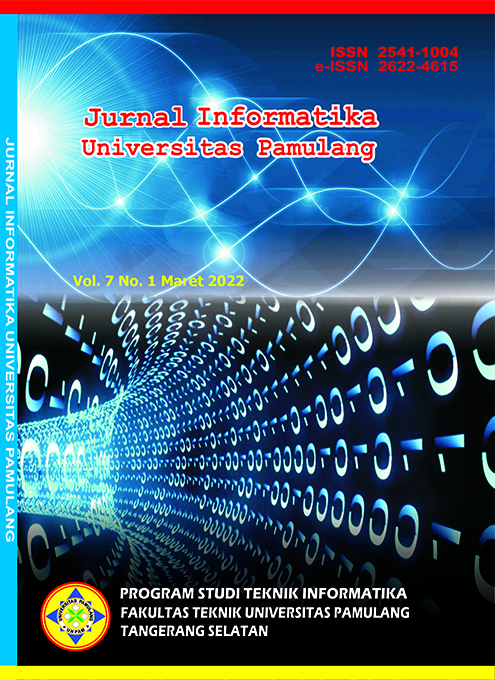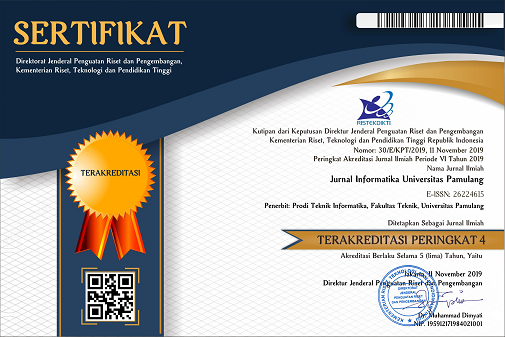Pemodelan Unified Model Languange Sistem Informasi Geografis Penentuan Lokasi Tempat Pembuangan Sampah Legal
DOI:
https://doi.org/10.32493/informatika.v7i1.14996Keywords:
Geographic Information System, Legal TPS, UML ModelingAbstract
In the development of an information system, a design or analysis stage is needed to identify system requirements to suit user needs. One of the design approaches in software development methodology is to use Unified Model Language (UML) modeling. UML modeling is a visual system design model that uses an object-oriented approach to make it easier for developers to design the system to be created. The analysis stage is the initial stage in identifying and designing the software requirements to be built. Making geographic information systems requires a reference in the design process so that it is easily translated by programmers in application development. One application of geographic information systems in the environmental field is mapping the distribution of legal waste disposal sites (TPS) in Pekanbaru City. Determination of legal TPS in the city of Pekanbaru is carried out by conducting surveys and measuring the area directly to the field. This of course takes time for officers to be able to recommend the area as a place to be used as a new TPS. The lack of information regarding the mapping of legal polling stations has also led to the emergence of illegal polling stations that can damage the environment. So it is necessary to build a geographic information system that can assist the Pekanbaru City Environment and Hygiene Service (DLHK) in determining recommendations for legal TPS-TPS locations based on spatial analysis and displaying a map of the distribution of existing TPS-TPS locations in Pekanbaru City. The development of this geographic information system was built with an object-oriented approach, so that in the process of analysis and design it uses UML Diagrams. UML diagrams made in this study are in the form of Use Case Diagrams, Usecase Descriptions, Activity Diagrams and Class Diagrams. The result of the research is that all the functionality designed in the use case diagram has been implemented in the application program 100%.
References
Booch, G., Rumbaugh, J., Jacobson, I., & Wesley, A. (1998). Unified Modeling Language User Guide, The Unified Modeling Language User Guide, The Library of Congress Cataloging-in-Publication Data.
DPMPTSP Provinsi DKI Jakarta. (2008). Undang Undang Republik Indonesia Nomor 18 Tahun 2008 Tentang Pengelolaan Sampah.
Haviluddin. (2011). Memahami Penggunaan UML ( Unified Modelling Language ). Memahami Penggunaan UML (Unified Modelling Language), 6(1), 1–15.
Herlina. (2021). Penerapan UML Pada Analisis Sistem Serta Perancangan Database Timbulan Sampah. Jurnal Informatika Sains Dan Teknologi, 6, 170–177.
Liputan6. (2016). Warga Pekanbaru Hasilkan 500 Ton Sampah Setiap Hari.
M Teguh Prihandoyo. (2018). Unified Modeling Language (UML) Model Untuk Pengembangan Sistem Informasi Akademik Berbasis Web. Jurnal Informatika: Jurnal Pengembangan IT, 3(1), 126–129.
Sutejo, S. (2016). Pemodelan UML Sistem Informasi Geografis Pasar Tradisional Kota Pekanbaru. Digital Zone: Jurnal Teknologi Informasi Dan Komunikasi, 7(2), 89–99. https://doi.org/10.31849/digitalzone.v7i2.600
Syahirah, Afifah; Fadhli, M. (2021). Analisa Spasial Lokasi tempat pembuangan Sampah Berbasis Web. 9th Applied Business and Engineering Conference, 1–11.
Downloads
Published
Issue
Section
License
Authors who publish with this journal agree to the following terms:
- Authors retain copyright and grant the journal right of first publication with the work simultaneously licensed under a Creative Commons Attribution-NonCommercial 4.0 International (CC BY-NC 4.0) that allows others to share the work with an acknowledgement of the work's authorship and initial publication in this journal.
- Authors are able to enter into separate, additional contractual arrangements for the non-exclusive distribution of the journal's published version of the work (e.g., post it to an institutional repository or publish it in a book), with an acknowledgement of its initial publication in this journal.
- Authors are permitted and encouraged to post their work online (e.g., in institutional repositories or on their website) prior to and during the submission process, as it can lead to productive exchanges, as well as earlier and greater citation of published work (See The Effect of Open Access).
Jurnal Informatika Universitas Pamulang have CC-BY-NC or an equivalent license as the optimal license for the publication, distribution, use, and reuse of scholarly work.
In developing strategy and setting priorities, Jurnal Informatika Universitas Pamulang recognize that free access is better than priced access, libre access is better than free access, and libre under CC-BY-NC or the equivalent is better than libre under more restrictive open licenses. We should achieve what we can when we can. We should not delay achieving free in order to achieve libre, and we should not stop with free when we can achieve libre.
Jurnal Informatika Universitas Pamulang is licensed under a Creative Commons Attribution-NonCommercial 4.0 International (CC BY-NC 4.0)
YOU ARE FREE TO:
- Share : copy and redistribute the material in any medium or format
- Adapt : remix, transform, and build upon the material for any purpose, even commercially.
- The licensor cannot revoke these freedoms as long as you follow the license terms





